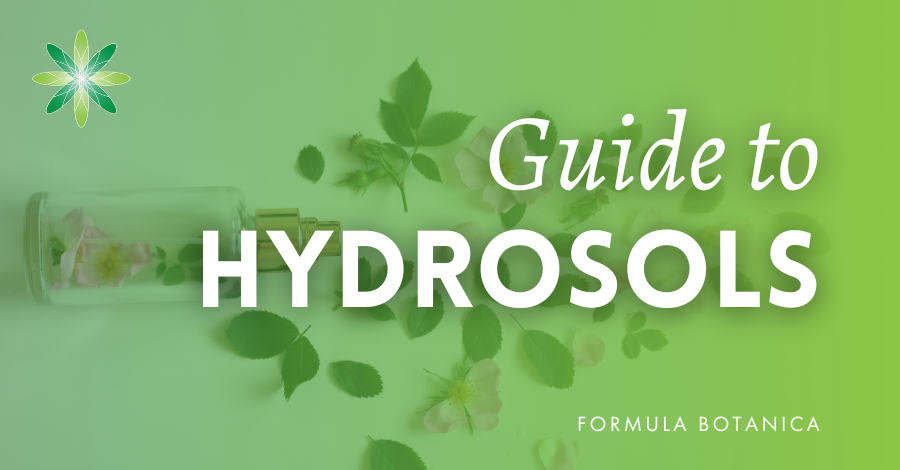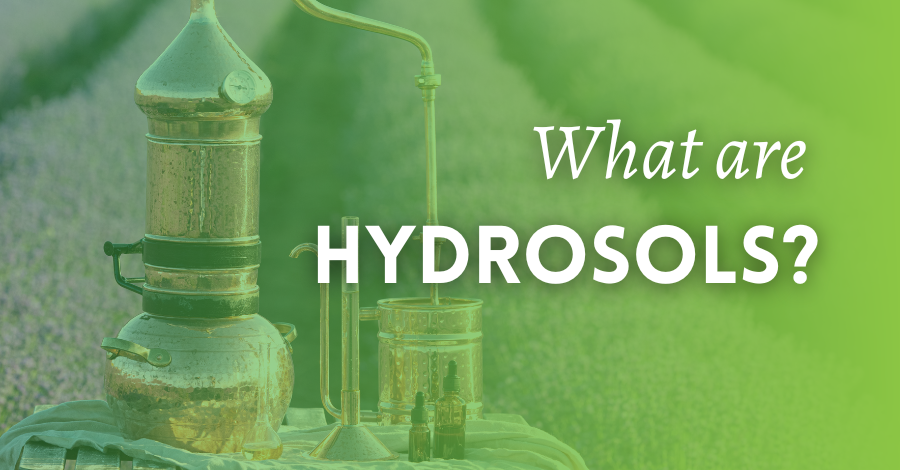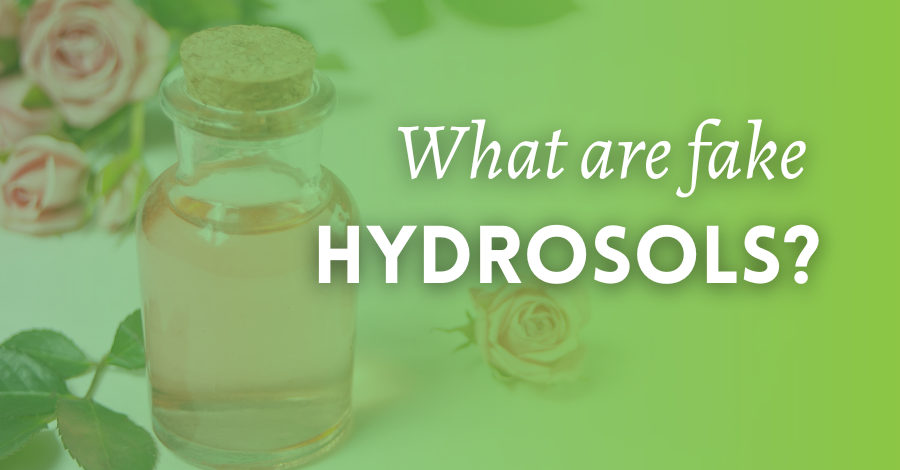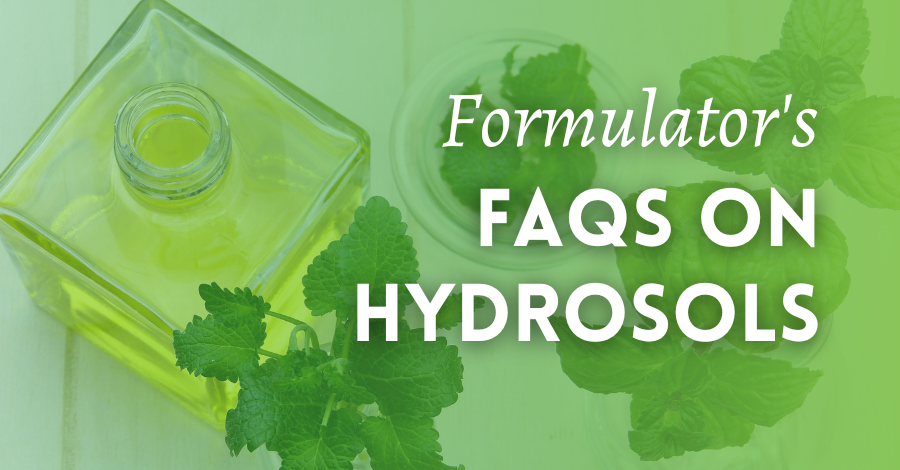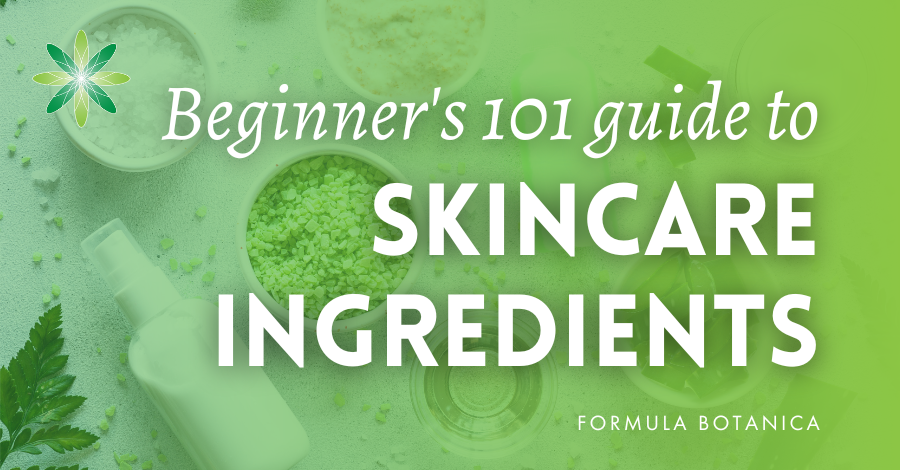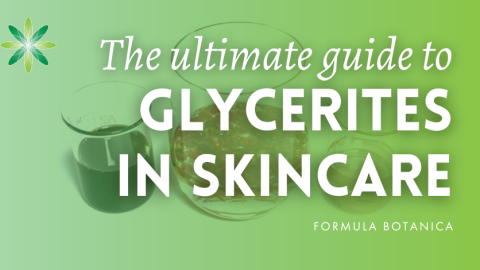Most of us are familiar with the popular Shakespeare quote, “a rose by any other name would smell as sweet”, but would we say the same of hydrosols, hydrolats, hydrolates, floral waters, flower waters, aromatic waters, aqueous distillates, herbal waters or flower distillates? Never has a type of cosmetic ingredient had so many different names or differences.
You have guessed it; the names above do not necessarily refer to the same type of product. For ease, let’s use hydrosol as the general term in this post as we discuss the differences between them.
The hydrosols we love using in our natural formulations for their beautiful scents and skin-beneficial as well as therapeutic properties may have been produced by a variety of methods. It is their method of manufacture that is key to knowing what category of hydrosol we are buying and just how effective our chosen hydrosol ingredient will be in our formulations.
As a general rule, hydrosol, hydrolat/hydrolate and distillates refer to genuine, pure hydrosols, but there is plenty of misleading labelling and descriptions on supplier websites.
In this guide to hydrosols, we look at the different production methods of the various floral and herbal aqueous ingredients, and also give tips on how best to use pure hydrosols in your formulations.
Why hydrosols are so popular
It is only in recent years that hydrosols have become valued ingredients in their own right, rather than being seen merely as byproducts of essential oil distillation. Their popularity has surged on account of the market growth of natural cosmetics, and also as formulators seek to replace essential oils, some of which may contain restricted allergens or be considered unsustainable to grow, harvest, process and ship.
Your use of pure hydrosols rather than essential oils in aqueous products can be a marketing angle for your cosmetics. Graduate brand Casa Mencarelli, whose organic cosmetics are aimed at people who suffer from acute allergies or have sensitive skin, specifically avoids essential oils, using instead hydrosols for their scent, colour and beneficial skincare properties.
What are pure hydrosols?
The manufacturing methods of hydrosol and similar products are the starting point for understanding these types of ingredients. In many cases, even the INCI of the hydrosol or hydrosol-type ingredient does not give you the full story, nor is it a guarantee that you know what you are buying.
Pure floral and herbal hydrosols are produced as byproducts of essential oil distillation. A few hydrosols are distilled from plants that do not yield essential oils (aloe and calendula are two examples). You will also come across hydrosols of some unlikely plants, such as nettle, which apparently can also produce essential oil. There is an infinite variety of hydrosols available today, but, as we will see, in order to know if they are genuine hydrosols, we need to do some research.
There are two types of distillation that use water:
- Hydrodistillation, in which the plant material is covered and boiled with water; and
- Steam distillation, in which the vapour passes through the plant material. In this process, the plant is placed in another chamber so it isn’t boiled along with the water.
When flowers, leaves, seeds, stems, bark and other botanical matter are distilled using either method above, the water vapour is collected and cooled to condense. At this point, the volatile essential oils rise to the top of the water which is bottled as the hydrosol.
This residual distilled water contains hydrophilic (water-loving) compounds, such as some antioxidants, and also minor amounts of some compounds present in the essential oil. However, these compounds are not the same as those found in a diluted essential oil, as there are different components in hydrosols. These other compounds in pure hydrosols are what make them so attractive to the natural formulator. You are not just using hydrosols for their light scent, but also to impart some other skin-beneficial properties to your formulations.
What are false hydrosols?
Essential oils are costly to produce, especially many of our most-loved floral oils such as rose and neroli. Jasmine cannot be effectively steam distilled, so its scented oil is extracted using a solvent to produce an absolute. This is also the case with orange blossom, which is an absolute. (As a side note, both neroli oil and orange blossom absolute derive from the flowers of the bitter orange, but neroli is produced through steam distillation while orange blossom is extracted using volatile solvents.)
Given the costs of harvesting raw botanical materials, some hydrosols, in particular floral ones, can be expensive. As you will have experienced, the price of essential oils varies widely from supplier to supplier and from year to year. Annual harvests vary and affect the supply of a botanical, and some essential oils may be adulterated with cheaper natural oils with a similar profile or simply be diluted. These are just some reasons why we may find floral waters masquerading as hydrosols. These floral waters are likely not produced as a byproduct of essential oil distillation, but by other, cheaper methods. Price is likely to be a key way to determine if you have a genuine hydrosol or not.
Some flowers and other botanical matter, such as jasmine, are rarely steam distilled, so you need to dig deep into supplier information to assess if your hydrosol is a true one. Your jasmine hydrosol, for example, is likely to be jasmine absolute or even a synthetic jasmine fragrance solubilised into water, or, in rare cases, a jasmine aromatic water produced through the distillation of the absolute. We have read, however, of a French manufacturer that does distil jasmine flowers solely for the production of a hydrosol and allows the blooms to steep in the water before distillation.
These points lead us nicely into the definitions of other floral water products that are not pure hydrosols produced during the steam distillation of botanical matter. This does not mean that these products are not 100 per cent natural, but it does impact their ability to offer skin-beneficial properties, as most will not contain the desirable organic compounds found in hydrosols. Understanding them will help you decide whether to choose and use them in preference to pure hydrosols.
- Floral or herbal waters with a solubiliser – 1% or less of essential oil solubilised into water. The solubiliser may be synthetic.
- Infused floral waters – a minute amount of essential oil (0.1% or so) agitated into water without the need for a solubiliser. Beware of the use of cheap/adulterated oils in this product.
- Condensed water – the condensed water collected from the drying of botanical matter. The INCI is likely to be identical to that of a pure hydrosol.
Typically, suppliers call these ingredients floral or flower waters rather than hydrosols, hydrolats or distillates. However, suppliers may erroneously mislabel these products or simply not know if their hydrosols are in fact floral or flower waters instead. We can’t stress enough the importance of digging deep and asking your suppliers some questions on the production methods and INCI of their hydrosols, flower waters, and so on. Try to build relations with reputable suppliers who can provide documentation for their products.
We have an entire article dedicated to helping you understand the differences between pure hydrosols and false hydrosols. We suggest you head over to read it now.
Formulating with hydrosols
In this section, we go over some key FAQs and points about using hydrosols in your cosmetic formulations.
Should I use preserved or unpreserved hydrosols?
Our recommendation is to always use preserved hydrosols and to obtain documentation from your supplier – the safety data sheet (SDS) and certificate of analysis (COA) – to determine which preservatives have been used. As natural formulators, we wish to avoid synthetic preservatives in our cosmetic formulations, and it may be tempting to avoid even those that are accepted in natural, organic formulations. However, it is far better to have a cosmetic that is preserved and safe for use than to risk producing a product likely to be contaminated already or to become contaminated quickly. Including an unpreserved hydrosol may contaminate your product at the formulation stage.
There is an increasing number of cosmetic ingredient suppliers offering unpreserved hydrosols. But, as we all know, water and aqueous ingredients run the risk of fast becoming a breeding ground for microbial contaminants – yeast, mould and bacteria. When hydrosols are manufactured in professional, industrial-scale facilities operating to GMP, they are packaged at the source in large drums. As indie formulators, we tend to buy hydrosols in low minimum order quantities (MOQs) that come repackaged in sizes ranging from around 100ml to five litres. If the hydrosol is left unpreserved in this rebottling process in the supply chain, there is a possibility it will become contaminated even before you get to use it.
We have an in-depth article on hydrosol preservation. It covers issues such as the preservation of a cosmetic product already containing a preserved hydrosol and similar frequently-asked questions.
Are hydrosols damaged in hot-process formulations?
Your hydrosols are already the product of hydrodistillation or steam distillation in which the water is heated and boiled for its vapour to carry the volatile compounds of essential oils. This means that it is not a problem to heat them, but, of course, as with most botanical ingredients, it is better if you can work with them by applying less heat or in cold processes to avoid damaging them.
What compounds are in my hydrosols?
The compounds in hydrosols can be quantified only through chromatography. This procedure is carried out on essential oils to determine their components, especially to calculate the percentage of any allergens present in them. Hydrosols may contain some – but not all – of the essential oil components and a few other hydrophilic compounds that aren’t present in the essential oil, but not necessarily so. Some compounds may be present in both ingredient types, but not in the same ratio. You can also find other, more hydrophilic compounds in hydrosols that you won’t find in essential oils. But do note that you won’t find vitamins or phytosterols in hydrosols because these aren’t volatile and will therefore not evaporate to be condensed in the distillate.
Why doesn’t my rose hydrosol smell like roses?
If you have bought, for example, rose hydrosol, you may have been surprised to find it smelled burned, musty or somehow ‘off’ to your nose and nothing like rose absolute or essential oil. You need to remember that a hydrosol is the distillate of botanical matter, which can include the stems, leaves and other parts of the plant. The gorgeously scented, volatile essential oil has been separated from the water and may be present, if at all, only in minute amounts in the hydrosol.
Your hydrosols may therefore smell more herbaceous and far less floral or like the original plant than you expect. Some hydrosol scents bear little or no resemblance to those of the plant or flower. We recommend buying small amounts of your chosen hydrosols from different suppliers to compare their profiles. In the case of hydrosols, a rose does not smell as sweet and also not as sweet from one supplier as the next.
The cost of using hydrosols
You will notice in some of our formulations on this site that we recommend not using too many expensive hydrosols within the water phase of rinse-off products, even if we love the scent and properties they impart. Certainly, as a beginner formulator, it is wise to test water-based and -containing formulas out first using only water. You can always swap a percentage of water later for hydrosols of your choice. The price factor comes into focus more if you are formulating a product to sell. Your brand positioning will determine whether your price point can absorb the cost of using pure hydrosols.
Explore formulating with hydrosols
We’ve selected just some of our formulations that include a high percentage of hydrosols or their counterparts.
Make a jasmine and aloe micellar water (see what kind of jasmine “hydrosol” or similar you can find to make this micellar water).
How to make a witch hazel toner
Formulate a simple gel face cleanser (78% of the formula is lavender hydrosol).
How to make a natural shower gel (using a 15% blend of orange and aloe vera hydrosols).
Make an anti-ageing hand cream (includes helichrysum hydrosol).
How to make a natural mint and rosemary shampoo
Formulate a strengthening hair mist (includes rose hydrosol).
Further reading
Here is a small selection of the many interesting scientific articles you can find on hydrosols and botanical distillates.
Almira Georgieva et al. (2019, Journal of Essential Oil Bearing Plants): Comparative Study of Phytochemical Profiles and Antioxidant Properties of Hydrosols from Bulgarian Rosa Alba L. and Rosa Damascena Mill.
Ellouze, I. et al (2010): Study of the composition variation of different distillate fractions of citrus aurantium L. obtained by steam distillation.
A. Kunicka-Styczyńska et al. (First published 29 October 2014): Preservative activity of lavender hydrosols in moisturizing body gels..
Anna Lante and Federica Tinello (Innovative Food Science & Emerging Technologies, Volume 27, 2015): Citrus hydrosols as useful by-products for tyrosinase inhibition.
FREE TRAINING
Learn how to become an
Organic Skincare Formulator
FREE TRAINING
How to become an
Organic Skincare Entrepreneur
FREE TRAINING
How to become an
Organic Skincare Entrepreneur
Leave us a comment

Liz was Formula Botanica’s Content Coordinator between August 2020-2024. Liz worked as a professional blogger, journalist and site developer for many years and was also part of the Formula Botanica student community. Read more about the Formula Botanica Team.

